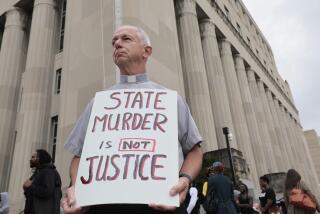High Court Reverses 30th Death Penalty in 33 Cases
SAN FRANCISCO — Reversing a death penalty for the 30th time in the 33 capital cases it has considered since 1978, the state Supreme Court ordered a partial retrial of a prison escapee who killed an elderly woman in her San Bernardino County home and then sat down to eat in front of her television set.
Acknowledging the “callous” behavior of the defendant, the unanimous court nonetheless concluded that it had no choice but to order a partial retrial for Stephen Wayne Anderson because the prosecution failed to prove that Anderson intended to commit a murder. The decision was based on two previous Supreme Court rulings, in 1983 and 1984.
The court said in the 1983 case that prosecutors must prove that defendants intended to commit murder before sentences of death or life in prison without parole can be imposed. The 1984 case made the requirement retroactive.
Thursday’s case was the fifth reversal based on those two decisions.
As it did in the other four cases, the state court affirmed Anderson’s 1981 murder conviction. But it ordered a retrial of the part of the proceedings in which the jury found that the murder was committed with “special circumstances,” the finding that automatically carries with it a sentence of death or life in prison.
The jury in the retrial will determine if the murder was intentional, and thus a murder with special circumstances. If that finding is made, jurors could then decide to reimpose a sentence of death or life in prison.
The case decided Thursday involved the May, 1980, murder of Elizabeth Lyman, 81. Anderson broke into Lyman’s home in Bloomington and when the woman awoke and sat up in bed, he fired a single shot, killing her.
Afterward, Anderson, a Utah prison escapee who admitted to police that he committed two other murders, ransacked the home, stole $120 and cooked some noodles. He was eating and watching Lyman’s television when police, called by neighbors, arrested him.
Wanted Money and Food
Anderson told police he broke into the home believing it was empty. Police quoted him as saying he intended to find money, and if that failed, to “get something to eat and to get out of there.”
When Lyman awakened, “I just reacted, out of fear . . . saw this figure coming towards me,” he was quoted as saying. “I didn’t know who it was, and I just shot. . . . I have bad eyes and--and it was just there and I reacted.”
“However callous such conduct may seem in retrospect,” Justice Stanley Mosk wrote for the court in a seven-page opinion, “it does not prove as a matter of law that he entertained a specific intent to kill at the moment he fired the gun.” (People vs. Anderson, crim. 22143.)
Justice Malcolm M. Lucas, in a one-paragraph concurring opinion, agreed that the court had no choice but to order a partial retrial, but he repeated his opinion that he disagreed with the original 1983 and 1984 rulings.
Atty. Gen. John Van de Kamp has said that as many as 95 Death Row cases may be reversed based on the 1983 and 1984 intent rulings. On Tuesday, the U.S. Supreme Court refused to hear the issue.
More to Read
Sign up for Essential California
The most important California stories and recommendations in your inbox every morning.
You may occasionally receive promotional content from the Los Angeles Times.










